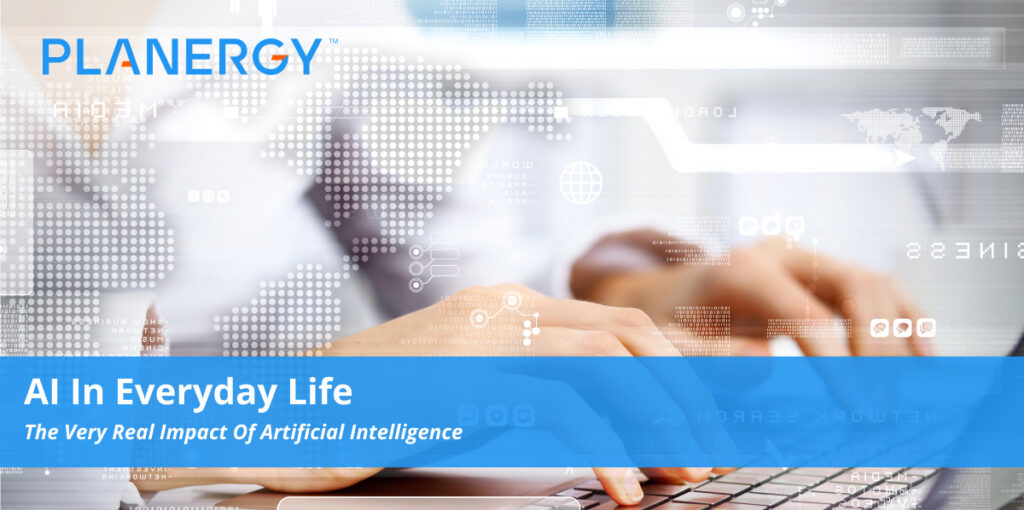From Asimov’s constrained robots to the helpful disembodied voice of the ship’s computer on Star Trek to the decidedly less friendly HAL 9000 in 2001: A Space Odyssey, artificial intelligence (AI) has long been a part of popular fiction, films, and television shows.
But as digital transformation continues to alter the ways in which humans work, play, and create, AI has moved from the realms of fantasy and science fiction to the jejune reality of social media, data management, and even business process automation.
Today’s artificial intelligence may not yet be on par with Asimov or Rodenberry’s flights of fancy, both AI in general and machine learning in particular are increasingly important to, and present in, human activities.
For business owners and companies of all sizes, understanding the impact of AI in everyday life makes it easier to take advantage of its capabilities and leverage its power and versatility in developing a competitive and productive organization.
How Do We Use AI in Everyday Life?
Have you ever asked Google Assistant, Microsoft Cortana, or Amazon Alexa for an answer or assistance? Unlocked your phone with just a quick glance?
Watched a recommended show on Netflix, Hulu, or another streaming service? Used predictive text to send a quick message?
Welcome to the future: You’re using AI technology.
Artificial intelligence is currently being used in everything from the driving directions served up by Google Maps to chatbots that answer questions without the need for human intervention.
Artificial intelligence and machine learning are often heralded as “emerging technologies.’ But the truth is, they’ve already emerged, and they’re being used in health care, social media, financial institutions, facial recognition, and (naturally) by online retailers to more efficiently provide the goods and services they want to sell you.
In a data-driven economy radically transformed by an always-on, high-speed Internet and supercomputer cell phones in everyone’s pocket or purse, algorithms designed to mimic human thought—and learn lessons they can use to improve their already powerful performance—are baked into all areas of life.
In business, applied artificial intelligence—i.e., transforming AI concepts into useful and practical applications— leverages algorithms for everything from advanced data mining to business process management to market analysis.
These algorithms use two of AI’s “children”—machine learning and deep learning—to process and analyze nearly unimaginable volumes of data at rates far beyond human capabilities.
Complex systems, such as traffic and banking transactions, are quickly and efficiently analyzed to reveal patterns that can be used to predict behavior, generate alerts, or identify potential problems before they blossom into disasters.
Advanced neural networks take the technology further, using AI algorithms to dig deep into advanced applications such as facial recognition, natural language processing (to further enhance voice- and text-based analysis that turn searches into conversations), and more.
These AI algorithms are both iterative and self-improving in real time.
Every query is a chance to refine the algorithm’s accuracy and speed a bit further, bringing it ever closer to the dream of truly emulating human thought and, perhaps one day soon, creativity.
In a data-driven economy radically transformed by an always-on, high-speed Internet and supercomputer cell phones in everyone’s pocket or purse, algorithms designed to mimic human thought—and learn lessons they can use to improve their already powerful performance—are baked into all areas of life.
Examples of AI in Everyday Life
AI relies on huge amounts of data to be successful. Fortunately, data’s in no short supply, and managing Big Data is one of the most important challenges organizations face both today and in the decades to come.
Everything from Web searches to driving patterns to photo and video uploads and streams fills the ocean of data waiting to be analyzed—and leveraged—by artificial intelligence algorithms.
To truly understand the scope and depth of AI’s presence in our culture, technology, and economy, we can take a closer look at more specific examples of artificial intelligence and how it’s being used in your everyday life.
Google Turns Data into Directions, Discoveries, and Diversions
Search engine giant Google has a wide array of applications available to its users, driven by insights gleaned from collected data.
Google Maps uses anonymized cell-phone data to analyze and predict traffic patterns in real time—and connects to traffic data to provide optimal driving (or walking, or biking) directions on demand.
Google Search parses a user’s past search history to make intelligent recommendations while they’re typing.
Gmail uses AI to filter suspicious messages automatically, and even offers a Smart Reply tool to generate swift, customized “smart replies” for quick answers without the need to compose a reply manually.
Google also owns YouTube, where AI algorithms are used to analyze both specific user behavior (viewing habits and likes) as well as the popularity of platform content to make recommendations it thinks viewers want to see.
Amazon: A Leader in AI Technology
Given its ability to provide in-home shopping, streaming entertainment, web hosting, and even a platform for starting a small business, it’s not exactly a surprise that global juggernaut Amazon is heavily invested in artificial intelligence.
Like Google, the company takes AI technology very seriously; it uses advanced algorithms designed to combine data in multiple dimensions to provide accurate, relevant, and swift search results.
The same goes for its Amazon Video service, where viewer behavior and the popularity of content are both analyzed to provide recommendations.
The company also recommends products to both visiting shoppers and more than 150 million Amazon Prime customers worldwide. It generates its recommendations with advanced neural networks that analyze vast amounts of consumer purchasing and browsing behavior.
In fact, the company’s so confident in its predictive analytics that it patented an “anticipatory shipping algorithm” that predicts the products people want and ships them before they even buy them.
Netflix Knows What You Want to Watch Before You Do
Competition has grown a little stiffer for Netflix since streaming came to dominate the digital entertainment marketplace.
But Netflix has been at this game since 2007, and the company has used the time to develop a complex algorithm it uses to analyze viewer behavior and make its often uncanny (and sometimes hilariously terrible) recommendations.
Safer, More Convenient Banking and Buying
No matter where you bank, chances are your financial institution is getting onboard with the AI revolution. Three AI-based technologies in particular—mobile deposits, credit decisions, and fraud protection—are increasingly popular options for consumers.
Using machine learning and neural networks, banks can parse account, behavior, and transactional data to verify a check image is valid, predict and identify fraud, and analyze an applicant’s credit history to avoid extending credit to high-risk customers.
Online retailers and credit card companies also use AI algorithms to help protect customers and provide better service. Credit card processor Square, for example, uses AI to detect and prevent fraud (along with false positives), and MasterCard uses AI to analyze spending patterns to shield its customers from fraud without creating headaches due to false positives.
Use Your Voice to Get Real-Time Answers—and Service
Whether you use Apple’s Siri, Amazon Alexa, Microsoft Cortana, or Google Assistant, chances are you spend at least part of your day talking to digital assistants that live in your phone, computer, or a smart speaker on the mantle.
People now use their voice to compose text messages and emails, manage their social and business calendars, and handle everything from answering trivia questions to ordering a pizza or booking a flight, whether they’re on Android or iOS.
If you happen to have smart home devices (e.g., Google Home or Amazon Alexa), you can even use them to turn on appliances, adjust the thermostat, or change your Spotify playlist on the TV, stereo, or computer.
AI algorithms, using natural language processing and deep learning, transform speech into data they can analyze. We’re not quite to the level of Iron Man’s Jarvis just yet, but it seems Facebook CEO Mark Zuckerberg wants to make that dream a reality in the very near future.
Social Media Blurs the Lines Between Digital Life and the Real World
And speaking of Facebook, advanced artificial intelligence is an essential part of not just the blue behemoth, but nearly every social media platform.
- Facebook uses AI for a bevy of different purposes, from deciding what to show to whom to ad targeting to advanced facial recognition that allows users to find photos of themselves for tagging (or untagging). It also uses a proprietary AI technology called DeepText to parse text for intent while removing spam and harvesting useful information for its own advertising and content management purposes.
- Facebook’s own Instagram uses “emojineering” to parse emojis for meaning and context in order to improve predictive text and emoji recommendations.
- Twitter uses artificial intelligence to rank content, combat hate speech, improve advertising relevance, and provide quality of life improvements.
- Apps like Reface make it possible to swap your face (or someone else’s) onto your favorite celebrities, sports stars, or memes using deep learning to analyze and generate high-quality face swaps in real time.
- Similarly, Snapchat’s Lenses technology tracks facial movements to generate digital effects and masks that sync to the user.
- The tasks for which folks currently use digital assistants may one day be just another part of their favorite social media platforms. Chatbots with the power to integrate with a variety of data environments (e.g., Google, Amazon, and Microsoft) could provide an intuitive, conversation-based method for eCommerce, managing your calendars, or paying your bills.
The Future of Healthcare
The use of AI isn’t limited to socializing or commercial endeavors. AI algorithms have powerful potential in the healthcare field, where deep learning, computer vision, and image analysis can improve remote diagnostics, machine learning can be used to create customized drugs and treatment regimens, and advanced data management can simplify administration and lower costs while improving patient experience.
Commuting in the Digital Age
Using its UberAI technology—which includes computer vision, natural language processing, and connections with the Internet of Things (IoT)—ride-sharing giant Uber verifies driver IDs manages demand and scheduling. It also continues to develop chatbot-style communication tools for users to get the answers, and rides they need quickly, safely, and easily.
In the future, commuters may be picked up by self-driving cars, powered by advanced AI that draws on a wide array of information to navigate the streets safely.
Artificial Intelligence Transforms Procurement into a Value Powerhouse
While it certainly has a substantial footprint in the realms of entertainment, personal finance, and commerce, artificial intelligence is also a critically important part of competing effectively in today’s global economy.
One of the most important applications of AI technology is in the field of procurement, where digital transformation is not just streamlining and speeding formerly tedious and error-prone processes, but reshaping the role of procurement itself.
Traditionally focused on securing immediate savings and cutting costs, the processes of obtaining goods and services and managing the company’s supply chain have become a hotbed of potential value for companies ready to make use of artificial intelligence in procurement.
The use of AI as part of a comprehensive procurement tool like PLANERGY makes it possible to capture, organize, and analyze all spend data flowing through an organization.
This provides immediate savings by eliminating rogue spend and discouraging fraud, but it also improves an organization’s ability to make smarter, more strategic business decisions.
Every task and workflow, from supplier relationship management to the procure-to-pay process, can be improved through the application of artificial intelligence.
Human error is eliminated; tedious, time-consuming, high-volume tasks are swiftly optimized and automated; staff is freed to apply their skills to strategic work that generates more value and savings over time.
Cash flow management and strategic planning are greatly improved, insulating the company against disruptions and helping to protect business continuity.
Integration brings together your company’s disparate data sources, further enriching the pool of available data for analysis.
Optimization and continuous improvement become part of your company’s overall business process management approach. Intuitive dashboards make it easier for senior management to generate reports, forecasts, and budgets in real time, using data they know to be complete and accurate.
Ultimately, artificial intelligence allows organizations to re-center procurement as a value generator and strategic leader, allowing for a more sprightly and competitive company that can leverage its data effectively to innovate and grow.
Ready to Leverage Artificial Intelligence in Daily Life?
You’re probably already using AI technology in your daily life on a personal level—but has your company tapped into its power to improve its efficiency, profitability, and competitive strength?
The intelligence may be artificial, but when you harness AI algorithms as part of your organization’s datasphere, you’ll get very real results.
Invest in AI tools today, and get ready to connect with customers, streamline workflows, optimize your supply chain, and transform big data into powerful, actionable insights.




